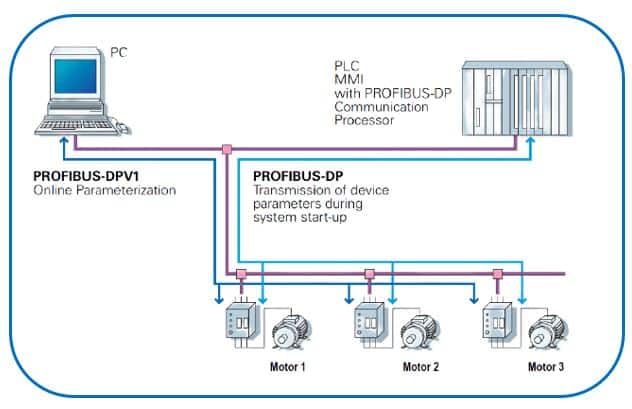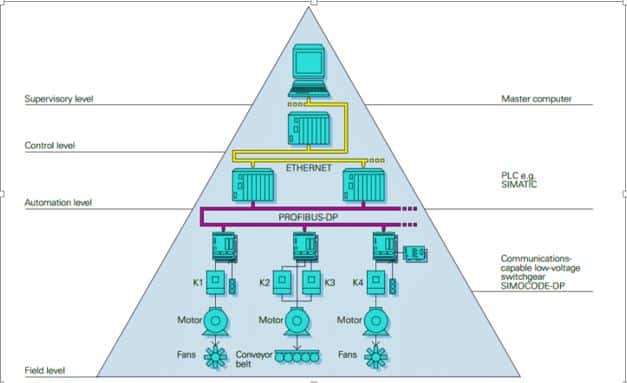What is MCC?
MCC – Motor Control Center– has all the operational and protective switch gears. The Motor Control center basically controls the motor operation. Therefore, it has all the control, monitoring, and protective electrical items necessary for the motor feeder. MCC has the following electrical items housed in a feeder.
- Switch Fuse Unit
- Molded Case Circuit breaker
- Power Contactor
- Auxiliary contactor
- protection relays
- Ammeter and Voltmeter
- Energy meter
- Indication lamps
- Selector switches
The conventional MCC has a lot of wiring. The signaling of the protection and metering items such as thermal or electronic overload relay, energy meter, and current transformer make the wiring of the feeder much more complicated. The protection class CTs have their connection with the motor protection relay. And, the metering class CTs have their connection with the ammeter, energy meter, and power factor meter. Thus, a conventional MCC has a lot of wiring. In spite of a lot of wiring, it does not provide the fault history. Therefore, intelligent MCC is the right solution.
Disadvantages of Conventional MCC?
- Conventional MCCs have a lot of wiring
- The cost of installation is more because of many switch gears and its wiring
- It is rather difficult to troubleshoot the fault.
- Fault history is not available in MCC, therefore troubleshooting is a major challenge. Moreover, in absence of historical data, predictive maintenance planning is difficult. Also, preventive maintenance is difficult to fix because feeder fault history is not available.
Nowadays, a lot of advancement is taking place every day in the automation field. What does automation do? The automation ease the operation and maintenance of the equipment. It reduces downtime and enhances productivity. It is now possible to operate a plant from a remote location.
Many advancements have been done in the conventional MCC to have communication with a central computer. The conventional MCC is now almost obsolete, and people are preferring intelligent or smart MCC.
What is Smart or Intelligent MCC?
Why MCC is called intelligent? When the MCC devices start communicating with a computer, it is possible to program the devices from a remote location. In addition to this, it is possible to record the motor running parameters and motor data history for analysis purposes.
An intelligent or smart MCC has intelligent devices- like current and voltage measuring modules with Profibus communication capability. The intelligent MCC measures and stores the measuring parameters like energy, power, power factor, reactive energy, and apparent energy. Also, it is possible to program the motor protection parameters like overload, blocked rotor, single-phase, over current, instantaneous overcurrent, and unbalance from the remote station. Intelligent MCC has the running hours of the motor and it is possible to plan the preventive maintenance of the motor and feeder.
Features of Intelligent MCC
A Smart MCC has the following intelligent devices to monitor & control the motors or other electrical loads.
- Dedicated Controller
- Intelligent current and voltage sensor
- 24 Volts input/output interface module
- Profibus communication port
All the feeders of MCC have unique slave addresses (ID) connected to the Profibus network. The dedicated intelligent voltage and current module, I/O modules, and other intelligent devices have their interface with the Profibus network. All motor feeders in intelligent MCC are configured for full load current, maximum voltage, alarms, faults, and trips, etc. We can connect a maximum of 126 intelligent devices in a network. The stand-alone SCADA monitors the motor parameters on a real-time basis, and the data transfers to the control room PLC or DCS system.
Working of Intelligent MCC
We can connect the different intelligent devices like intelligent feeders, variable frequency drives, dc drives, pressure transmitters, or any devices in a Profibus network that are compatible with Profibus communication.

A smart MCC has intelligent devices like the current module, voltage module, and controller in the MCC which capture the motor operating data and communicate the same to PLC or process control system on a real-time basis.
The following motor protection data is sent to PLC & SCADA on a real-time basis.
- Overload
- Over-current
- Instantaneous overcurrent
- Locked Rotor current
- Earth Fault
- Instantaneous Earth Fault
- Phase Failure
- Current unbalance
- Under current
Thus, the motor protection signal operates very fast in the case of the above-mentioned fault, and PLC issues a trip command. The motor thus trips in no time, and as a result, the reliability of the motor increase.
In addition to the above, we can program all the motor protection data remotely from the PLC control room. The energy, current, voltage, power, and running hours are recorded in the computer. The running hours recorded data is used for preventive maintenance of the motor.

Advantages of Smart or Intelligent MCC
- All the intelligent devices are in the loop on Profibus-DP. Therefore, the speed of data is very fast. The data capturing and decision-making are on a real-time basis.
- The intelligent MCC requires very less wiring. All the analog and digital signal communication are on Profibus, and therefore there is no need for additional I/O modules.
- Motor protection data can be programmed from PLC/SCADA through a remote programming station with the respective software. Therefore, it is very easy to program intelligent MCC.
- The lesser wiring in an intelligent MCC leads compact size of the panel.
- The history data of the motor is available in event history, and it helps in preventive maintenance of the motor.
- Overload protection or other faults in the motor is quickly sensed in the PLC, and PLC trips the motor. It leads to increased life of the motor.